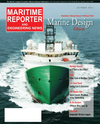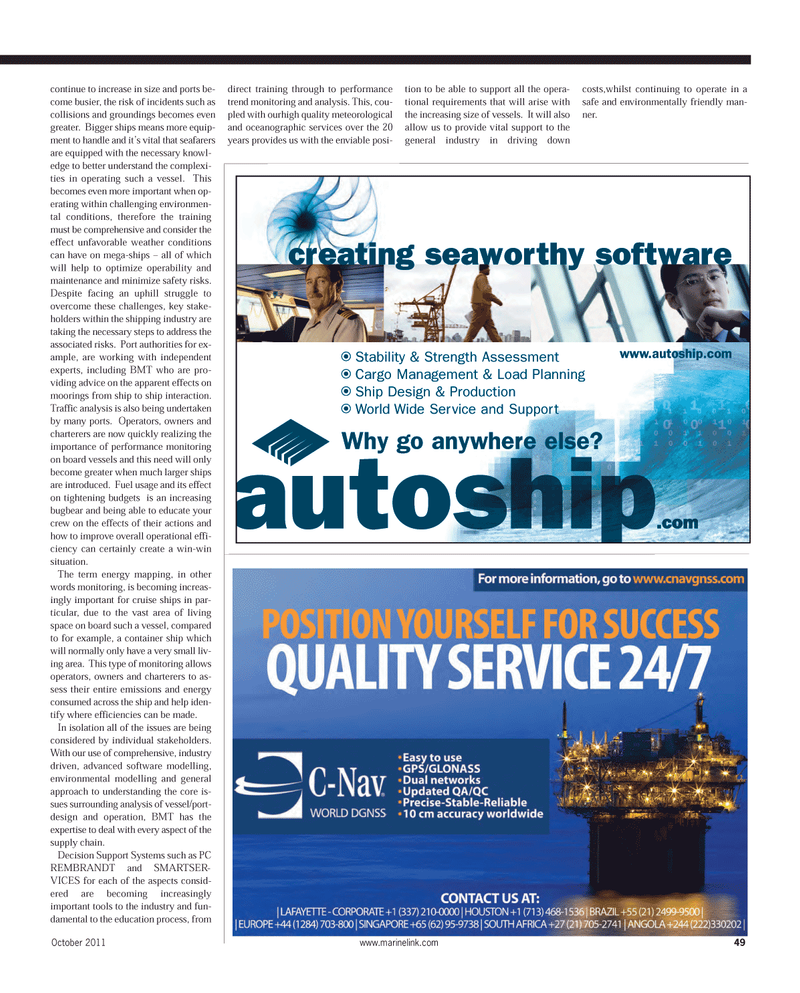
Page 49: of Maritime Reporter Magazine (October 2011)
Marine Design Annual
Read this page in Pdf, Flash or Html5 edition of October 2011 Maritime Reporter Magazine
continue to increase in size and ports be-come busier, the risk of incidents such as collisions and groundings becomes even greater. Bigger ships means more equip- ment to handle and it?s vital that seafarers are equipped with the necessary knowl- edge to better understand the complexi- ties in operating such a vessel. This becomes even more important when op- erating within challenging environmen- tal conditions, therefore the trainingmust be comprehensive and consider the effect unfavorable weather conditions can have on mega-ships ? all of which will help to optimize operability andmaintenance and minimize safety risks.Despite facing an uphill struggle to overcome these challenges, key stake- holders within the shipping industry aretaking the necessary steps to address theassociated risks. Port authorities for ex- ample, are working with independent experts, including BMT who are pro- viding advice on the apparent effects on moorings from ship to ship interaction.Traffic analysis is also being undertaken by many ports. Operators, owners and charterers are now quickly realizing the importance of performance monitoringon board vessels and this need will only become greater when much larger ships are introduced. Fuel usage and its effect on tightening budgets is an increasing bugbear and being able to educate your crew on the effects of their actions and how to improve overall operational effi- ciency can certainly create a win-win situation.The term energy mapping, in other words monitoring, is becoming increas- ingly important for cruise ships in par- ticular, due to the vast area of living space on board such a vessel, compared to for example, a container ship which will normally only have a very small liv- ing area. This type of monitoring allows operators, owners and charterers to as- sess their entire emissions and energy consumed across the ship and help iden-tify where efficiencies can be made. In isolation all of the issues are beingconsidered by individual stakeholders. With our use of comprehensive, industry driven, advanced software modelling, environmental modelling and general approach to understanding the core is-sues surrounding analysis of vessel/port- design and operation, BMT has theexpertise to deal with every aspect of the supply chain. Decision Support Systems such as PCREMBRANDT and SMARTSER- VICES for each of the aspects consid-ered are becoming increasinglyimportant tools to the industry and fun-damental to the education process, fromdirect training through to performancetrend monitoring and analysis. This, cou- pled with ourhigh quality meteorologicaland oceanographic services over the 20 years provides us with the enviable posi- tion to be able to support all the opera- tional requirements that will arise withthe increasing size of vessels. It will also allow us to provide vital support to the general industry in driving down costs,whilst continuing to operate in asafe and environmentally friendly man- ner. Stability & Strength Assessment Cargo Management & Load Planning Ship Design & Production World Wide Service and Support creating seaworthy software www.autoship.com Why go anywhere else? October 2011www.marinelink.com 49MR Oct.11 # 6 (42-49):MR Template 10/5/2011 1:03 PM Page 49

 48
48

 50
50
